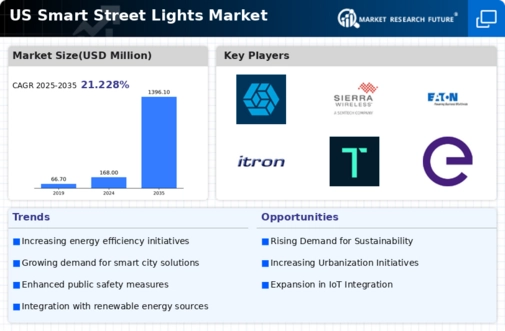Rising Urbanization
The trend of rising urbanization in the U.S. is a significant driver for the smart street-lights market. As more people migrate to urban areas, the demand for efficient and effective public services, including street lighting, increases. Urban centers are facing challenges related to traffic congestion and public safety, which smart street-lights can help mitigate. The integration of smart technologies allows for adaptive lighting solutions that respond to real-time conditions, enhancing both safety and energy efficiency. It is estimated that urban areas will account for over 80% of the U.S. population by 2050, further emphasizing the need for innovative lighting solutions. This demographic shift is likely to propel the smart street-lights market as cities seek to modernize their infrastructure.
Technological Advancements
Technological advancements are a driving force in the smart street-lights market. Innovations in LED technology, sensors, and connectivity options have made smart street-lights more efficient and cost-effective. The transition from traditional lighting to smart systems is facilitated by the decreasing costs of these technologies. For example, the price of LED lights has dropped significantly, making them more accessible for municipalities. Furthermore, the integration of IoT and AI technologies allows for enhanced data collection and analysis, leading to improved operational efficiency. The smart street-lights market is expected to witness a surge in adoption rates, with projections indicating a market value exceeding $10 billion by 2030. These advancements not only enhance functionality but also contribute to sustainability goals.
Environmental Sustainability Goals
The increasing emphasis on environmental sustainability is a crucial driver for the smart street-lights market. As cities strive to reduce their carbon footprints, smart street-lights offer a viable solution by utilizing energy-efficient technologies. The shift towards renewable energy sources, such as solar-powered street-lights, aligns with broader sustainability initiatives. Municipalities are increasingly adopting smart lighting systems that can significantly lower energy consumption, with estimates suggesting reductions of up to 50% compared to traditional lighting. This focus on sustainability is not only beneficial for the environment but also aligns with public expectations for greener urban spaces. Consequently, the smart street-lights market is likely to expand as cities prioritize eco-friendly solutions.
Government Initiatives and Funding
Government initiatives play a pivotal role in the smart street-lights market. Various federal and state programs are increasingly allocating funds to enhance urban infrastructure, which includes the deployment of smart street-lights. For instance, the U.S. Department of Transportation has introduced grants aimed at modernizing transportation systems, which often encompass smart lighting solutions. This financial support is crucial as it encourages municipalities to invest in advanced lighting technologies. The smart street-lights market is projected to grow significantly, with estimates suggesting a compound annual growth rate (CAGR) of around 20% over the next five years. Such initiatives not only improve public safety but also promote energy efficiency, thereby driving the market forward.
Public Demand for Smart City Solutions
Public demand for smart city solutions is a notable driver of the smart street-lights market. Citizens are increasingly advocating for improved urban infrastructure that enhances quality of life. Smart street-lights, which offer features such as adaptive lighting and integrated sensors, respond to these demands by providing safer and more efficient public spaces. The growing awareness of smart city concepts has led to increased pressure on local governments to implement such technologies. Surveys indicate that over 70% of urban residents support the adoption of smart technologies in their cities. This public sentiment is likely to influence policy decisions and funding allocations, thereby propelling the smart street-lights market forward as municipalities seek to meet the expectations of their constituents.





















Leave a Comment